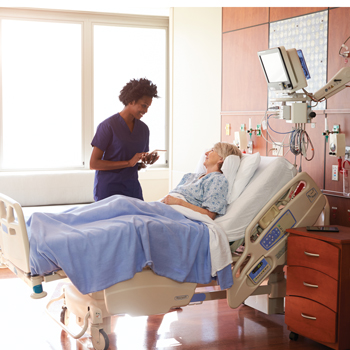
To lie down, perchance to sleep
Internists are good at picking up on obstructive sleep apnea, but chronic insomnia is underdiagnosed among a sleepy patient population.
Chronic insomnia is widespread and chronically underdiagnosed.
“In general [primary care doctors] are doing a very good job picking up signs and symptoms of obstructive sleep apnea,” said James K. Wyatt, PhD, director of the Section of Sleep Disorders and Sleep-Wake Research at Rush University Medical Center in Chicago. “And they are doing a very good job of getting those folks to sleep centers. But what I think is woefully underdiagnosed is insomnia.”
Chronic insomnia, the inability to sleep three nights or more a week for more than three months, occurs in about one in 10 adults, he said. “Sleep disorder centers should be absolutely overwhelmed by these patients to deliver cognitive behavioral treatment.”
Source of the problem
Sleep is primarily driven by two cycles, the homeostatic drive to sleep and an underlying circadian rhythm. These can become unsynchronized, explained Henry Klar Yaggi, MD, MPH, director of the Yale Program in Sleep Medicine.
The homeostatic sleep drive increases the longer a person is awake and typically peaks at nighttime before starting sleep, said Dr. Yaggi, an associate professor of medicine in the department of internal medicine at Yale University School of Medicine in New Haven, Conn.
The circadian rhythm is controlled by a master clock or pacemaker, known as the suprachiasmatic nucleus in the hypothalamus of the brain. That pacemaker is constantly being trained by light and dark cycles, with melatonin acting as the underlying natural biomarker.
“Oftentimes, our circadian rhythm and our drive to sleep are coupled, which makes it quite conducive to initiate sleep,” Dr. Yaggi said. “But sometimes there can be an uncoupling of our circadian rhythm.”
The circadian rhythm can creep forward, which is very common among older people, or can become delayed, which is common among adolescents or young adults. Dr. Yaggi added that the cycle can become free entirely, such as in patients who are blind; can be disrupted by shift work; or can lag, as long-distance airline passengers can attest.
Another model used to describe insomnia is called the three-P model, Dr. Yaggi said:
- predisposing factors such as anxiety, worry, or decreased homeostatic drive;
- precipitating factors such as medical or psychiatric illnesses, shift work, and stressful life events; and
- perpetuating factors, such as the development of counterproductive efforts to sleep, poor sleep hygiene, and psychological classic conditioning.
Make the diagnosis
Regardless of the cause, there can be consequences to not getting enough sleep, said Dr. Wyatt, who describes sleep health as a prevention strategy. “We know that chronic insufficient sleep can make people gain weight. It can throw off glucose regulation and insulin sensitivity. It can hurt the immune system. It can increase the risk for accidents and injuries. It increases the risk for anxiety and mood disorders,” he said.
When a patient arrives in an internist's office, the first step is triage, Dr. Wyatt said. Is the patient reporting insomnia, having trouble falling asleep or staying asleep, versus signs of another sleep disorder, such as restless leg syndrome or sleep apnea? Or, like many Americans, they might just be sleep deprived. The CDC noted in its Feb. 19 MMWR that one in three people don't get enough sleep and concluded that people need to make sleep more of a priority in their busy lives.
“For those patients who are only spending five or six hours in bed every night, part of it is trying to motivate them how to figure out how to adjust their daily activities to permit more time in bed,” Dr. Wyatt said. “Sometimes it's just problem solving and time management strategies.”
Internists can use the history and physical to look for barriers or contributors to poor sleep, such as excessive caffeine use, daytime napping, or erratic weekday versus weekend sleep schedules, Dr. Wyatt said. They can also screen for untreated anxiety or depression. There is an educational component to the exam, too, he noted, as physicians should let patients know what to expect about sleep. The normal adult needs somewhere between seven to nine hours of sleep a night. It's normal to take somewhere between 10 to 30 minutes to fall asleep, and while it's normal to wake up during the night, people shouldn't be awake more than a half-hour in total, he said. People should have a reasonable level of daytime alertness and energy to get through the day, he noted.
Another aspect to tease out during a primary care visit is whether a sleep-deprived patient gets insufficient sleep during the work week and catches up on the weekends. “Which is better than not catching up,” Dr. Wyatt said, “but a better strategy is to try to devote more time to sleeping on the work nights so they don't have to spend excessive hours catching up on the weekends.”
Lisa Medalie, PsyD, CBSM, a behavioral sleep medicine specialist at The University of Chicago, advises primary care physicians to also evaluate for primary conditions that may be causing insomnia. Medications (e.g., prednisone, psychostimulants), psychiatric disorders (e.g., depression, anxiety) and various medical problems (e.g., chronic pain, reflux, frequent urination, sleep apnea) may also be causing insomnia. Sometimes these issues can result in a bi-directional relationship. For example, pain can cause insomnia, and when people don't sleep they are more sensitive to pain, which then makes them vulnerable to further insomnia.
“In the clinic, you can sometimes get a sense for whether something seems primary if you ask questions, such as ‘Did you ever have trouble sleeping before the pain condition started?’” said Dr. Medalie. If not, treat the pain, then the insomnia. But if the person can't sleep regardless of when he or she had pain, the clinician can start treating insomnia right away.
Food, drink as sleep pitfalls
Caffeine is one of the big insomnia causes that physicians commonly see, Dr. Wyatt said. The U.S. average is 250 mg of caffeine a day, or about 2.5 cups of coffee. “Coffee is fairly good at keeping people awake when they are sleep deprived, but at the cost of hurting the depth and restorative benefits of subsequent nighttime sleep,” he said. A 16-oz coffee can contain 330 mg of caffeine, “far more caffeine than anyone ever needs in a day,” he noted.
Dr. Wyatt said there is a consensus that any person who requires that much caffeine to stay awake during the day has a sleep disorder. However, he said, “To me, high caffeine use is a warning sign. Too much caffeine will impair the depth of your nighttime sleep, which makes you feel sleepy the next day, hence you feel like you need even more caffeine. So people get caught in this vicious cycle.”
And while a cardiologist may want a patient to have one or two glasses of wine during the day for heart health, the sleep specialist will add, “Just not before bedtime.” Dr. Wyatt explained that if a patient has a partially collapsible airway, alcohol before bed might turn snoring into sleep apnea. Alcohol also impairs sleep because as it is clearing the bloodstream, a rebound of alertness occurs. A person having a nightcap might wake up a couple of hours later and have difficulty getting back to sleep. Additionally, alcohol is a diuretic, so it will increase nighttime bathroom trips, Dr. Wyatt said.
Another problem is that alcohol “fragments sleep significantly and can have effects that, even days after someone having a drinking episode, they can still be trying to recover,” said Dianne M. Augelli, MD, an assistant professor of medicine at Weill Medical College of Cornell University in New York.
An additional culprit is eating too close to bedtime, which can cause reflux that wakes a patient and causes discomfort, she said. “Those are good questions for an internist to ask.”
Sleep hygiene
The first step to treating chronic insomnia is to have patients create a positive sleep environment, a concept known as sleep hygiene, the experts said.
One cause of insomnia is not having adequate time to wind down before going to bed, Dr. Wyatt said. Busy families deal with kids' homework, catch up on work after leaving the office, and do household chores, then try to hop straight into bed. People need a half-hour or more of low physical activity to wind down to have a better chance of falling asleep rapidly, he noted.
People should avoid using their electronic devices in the bedroom, including televisions, smartphones, tablets, and laptops, Dr. Wyatt added. If they can't break the electronic leash, they should at least turn the screen brightness down or use apps that block the blue light. All electronic screens are enriched with light in the blue visible spectrum, a specific range described in some apps as 460 to 480 nanometers. This light spectrum inhibits the body's natural release of melatonin, which would normally begin about two hours before going to bed, Dr. Wyatt said.
Dr. Augelli advises patients to have a set number of hours to spend in bed. “Sometimes when people have insomnia they spend more time in bed to compensate. If someone says they are sleeping for five hours, and they are in bed for eight … the non-sleep time is usually filled with frustration and anxiety. Ideally, restricting time in bed to a reasonable number of hours is best until sleep improves,” she said.
If patients wake up in the middle of the night, they should avoid watching the clock, because that will give them anxiety, she continued. She advises patients to leave the bedroom after 20 minutes of midnight wakefulness, do something relaxing—reading is generally recommended—and then go back to bed. They should get up at the usual time the next morning.
“Create an environment conducive to sleep,” she advised. “Make sure it's cool, dark—that might include the use of blackout curtains to reduce the amount of light—and that it's quiet. Ensure that there are no pets or other interruptions that may impair their ability to go to sleep. You don't want to try to medicate over a cat or a dog.”
CBT-I as initial treatment
The next step for the perpetually sleepless patient is a referral for cognitive behavioral therapy for insomnia (CPT-I), a foundation of ACP's recent clinical practice guideline on the treatment of chronic insomnia disorder.
The guideline, which appeared in the July 19, 2016, Annals of Internal Medicine, offers two basic recommendations. The first is that all patients should receive CBT-I as the initial treatment for chronic insomnia disorder. The second is that clinicians should use a shared decision-making approach, including a discussion of the benefits, harms, and costs of short-term use of medications, to decide whether to add pharmacologic therapy in adults with chronic insomnia.
During a lecture at Internal Medicine Meeting 2017, Dr. Yaggi listed the benefits of CBT-I that led ACP to recommend it as the initial therapy:
- decreased sleep latency (the time it takes to initiate sleep),
- decreased wakefulness at night (increased sleep efficiency),
- improvements that often last six to 12 months,
- no associated adverse events, and
- many methods for administering therapy.
“The main limitation of CBT-I is the lag time,” Dr. Yaggi said. “It often takes five to eight weeks to realize the full benefit of this therapy. In contrast to CBT-I, pharmacologic agents for insomnia act immediately.”
But, he cautioned, there are also significant safety concerns with sleep drugs:
- daytime drowsiness,
- memory and psychomotor impairment,
- increased risk of falls,
- abnormal thinking,
- behavioral and mood changes, and
- complex disorders such as sleep driving.
What to expect from CBT-I
Dr. Medalie explained that CBT-I typically involves as few as five to eight visits, once per week. (If the patient is already on insomnia medications and the prescribing physician is interested in having the insomnia specialist assist with tapering, there can be as many as 10 visits.) The overall goal is to teach patients how to get better control over thoughts and emotions so they can more effectively train themselves to sleep.
At the first visit, the clinician will obtain a sleep history; ask about any potential comorbidities that involve psychiatric, medical, or medication causes of insomnia; and look for symptoms of sleep disorders that may need to be ruled out before starting insomnia treatment, she said. Following that initial evaluation, patients will complete baseline sleep logs and work on sleep hygiene.
Subsequent visits include use of sleep restriction and stimulus control. This involves the clinician creating a structured sleep-wake schedule according to baseline data, essentially a prescribed sleep window to boost sleep drive. The patient is also given detailed instructions to get out of bed when not sleeping and what to do during that time. Patients can also learn relaxation strategies to lower their somatic arousal level and improve control over their emotional response to sleep troubles, Dr. Medalie said.
“Worry time” can be taught to patients as a way to minimize the interference of problem thoughts on sleep. Patients can list issues that might keep them awake, then address them with cognitive restructuring. Cognitive restructuring can be used to help decrease the “mind racing” often reported by patients with insomnia. They are taught to identify cognitive errors that might be causing reactions that prevent sleep and to create more logical thought processes that don't interfere with sleep, Dr. Medalie said.
“Using these evidence-based strategies is shown to help 70% to 80% of people struggling with chronic insomnia,” she said.
Dr. Yaggi added that most patients undergo CBT-I therapy with a clinical psychologist but added that new methods involve group sessions, telemedicine, and Internet-based delivery (see sidebar on page 13 for additional resources).
Medication after other treatments
If sleep hygiene and CBT-I do not cure chronic insomnia, internists can consider medications. Dr. Augelli advised that a short course of sleep drugs might stabilize sleep. Then, the physician can taper the medication as needed.
Medications are not advised for patients with substance abuse histories, people who have already high medication demands from chronic illnesses, and seniors, Dr. Augelli said. “Certainly in the elderly, try to stay away from medications such as Benadryl or other antihistamines, because of cognitive side effects. It's generally not a good idea to recommend that, even though it's over the counter,” she said.
Dr. Medalie said she sees patients who are taking prescription sleep aids when they start treatment and have sometimes been taking them for decades. Gradual tapering is key. “Patients should never ‘cold turkey’ stop a sleeping pill,” she said. If this is done, “They are going to sleep worse than they ever have.”
If patients obtain consent from their primary care doctor to taper, the insomnia specialist can walk the patient through this process while, at the same time, administering CBT-I, said Dr. Medalie, who will generally recommend decreasing the dose 25% every two weeks as part of an evidence-based approach.
A special caution is warranted when considering prescribing zolpidem, she continued, because the FDA has changed the maximum dose for women to no more than 5 mg, or 6.5 mg for extended release. Primary care offices are referring women who are on a 10-mg dose, or 12.5-mg extended release, Dr. Medalie said. Research also shows adults above the age of 65 are at increased risk for falls and cognitive troubles on certain sleeping pills. “These groups of patients are excellent candidates for gradual sleep aid tapering with concomitant CBT-I by an insomnia specialist,” she said.
Other patients she sees have been receiving nightly prescriptions for benzodiazepines or other powerful sleeping drugs, Dr. Medalie said. “They can be habit forming, and it's really challenging to get patients off of them. … If they take these medications, they are designed for occasional, and not nightly, use.”
She noted that the antidepressant trazodone is the second most commonly used medicine for insomnia, although it gets less attention and is not specifically indicated for this condition. It's used in low doses of 25 or 50 mg for insomnia if someone does not respond to CBT-I.
“In those cases where someone is nonresponsive to CBT-I, I'd rather see someone prescribed something like trazodone, which has a lower side effect profile and is less habit-forming than other commonly used sleep medications,” she said.
The key to starting the whole process of insomnia treatment is to recognize what's going on, Dr. Medalie concluded. According to a study published by Sleep Medicine in April 2015, Dr. Medalie said, about 10.8% of Americans meet the DSM-V standard for chronic insomnia. “We're talking about a lot of people here,” she said.





